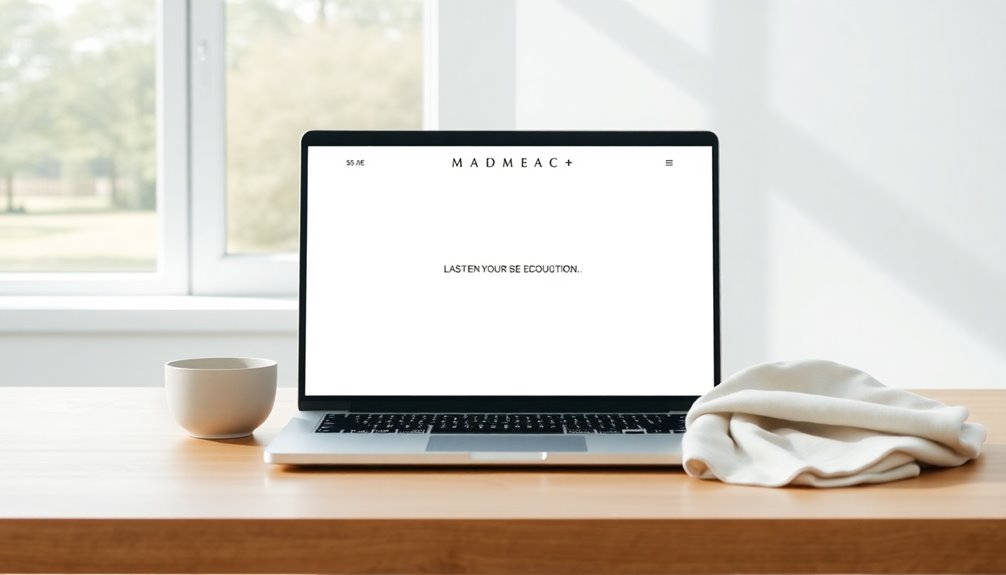Minimalism is reinventing e-commerce design by focusing on simplicity and clarity. You'll find that clean layouts and ample whitespace make navigation effortless, keeping users engaged while reducing decision fatigue. Brands like Everlane and Apple put this into practice, showing a boost in conversion rates. With optimized images and streamlined menus, minimalist designs improve loading times and mobile responsiveness, enhancing user experience. Keep exploring to see how you can apply these principles to elevate your online store.
Key Takeaways
- Minimalism enhances user experience by reducing clutter, resulting in lower bounce rates and higher conversion rates in e-commerce platforms.
- Clean, whitespace-driven designs facilitate straightforward navigation, making product searches quicker and more efficient for users.
- High-quality visuals and concise descriptions in minimalist layouts elevate brand perception, conveying sophistication and quality to consumers.
- Streamlined content and optimized images improve site loading times, leading to better search engine rankings and user retention.
- Collaborative efforts between design teams and content creators ensure messaging aligns with minimalist principles, enhancing clarity and guiding user actions effectively.
The Principle of Minimalism in E-Commerce

When you explore e-commerce design, you'll quickly realize that the principle of minimalism stands out for its "less is more" approach. By focusing on essential elements, minimalist design principles enhance user experience on your e-commerce site.
Brands like Apple and Google showcase how a clean design with ample whitespace and straightforward navigation fosters clarity. This streamlined layout helps users concentrate on products, greatly reducing decision fatigue and analysis paralysis.
Consequently, studies show that employing a minimalist approach can decrease bounce rates by 20% and increase conversion rates by up to 15%. By eliminating clutter, you not only simplify interactions but also elevate your brand's perception, conveying sophistication and quality through a focused visual experience. Additionally, leveraging automated insights can further optimize the user experience by providing personalized recommendations based on consumer behavior.
Benefits of Minimalist Design for Online Retail

Minimalist design enhances user engagement by creating a clean and focused shopping experience. This simplicity streamlines your decision-making process, allowing you to quickly find what you need without distractions. As a result, you're more likely to make purchases and enjoy your time on the site. Moreover, it facilitates AI-driven analysis that helps retailers optimize their online presence by understanding customer behavior and preferences.
Enhanced User Engagement
Clutter-free e-commerce design can dramatically enhance user engagement by allowing you to focus on what truly matters: your products.
With a minimalist design, you create an uncluttered interface that directs attention to high-quality product images and clear calls to action. This streamlined navigation makes online shopping more intuitive, leading to quicker access to what your customers want.
Enhanced user engagement results in a better customer experience, as fewer distractions reduce decision fatigue. Research shows that sites with minimalist aesthetics often enjoy lower bounce rates and higher average order values. Additionally, adopting a user-friendly interface can further improve customer satisfaction, encouraging repeat visits.
Streamlined Decision-Making Process
By simplifying the user experience, e-commerce sites can greatly enhance the decision-making process for customers. Minimalist design reduces clutter, lowering cognitive load and allowing you to make choices more efficiently.
Here are some key benefits:
- Streamlined navigation: Find what you need quickly, reducing frustration and keeping you engaged.
- Fewer distractions: Focusing on essential elements minimizes decision fatigue and prevents analysis paralysis.
- Higher conversion rates: Case studies show a 15% increase in conversions due to clearer choices.
- Faster loading times: Enjoy a seamless experience that boosts user satisfaction and supports quicker decision-making.
Incorporating these elements guarantees a frictionless journey, making your online shopping experience more enjoyable and effective. Additionally, adopting continuous improvement practices helps ensure that your e-commerce platform remains user-friendly and evolves with customer needs.
Case Studies: Brands Leading the Minimalist Charge

Let's explore how top brands are embracing minimalist design to enhance their e-commerce success.
Everlane, Apple, and Warby Parker showcase how simplified layouts not only engage users but also boost sales.
You'll see how these brands effectively use minimalism to create a seamless shopping experience that resonates with consumers. By focusing on functional layout principles, they maximize user engagement while minimizing distractions.
Successful Minimalist Examples
While many brands struggle to make an impact online, those embracing minimalist design are setting themselves apart in the e-commerce landscape.
Here are four standout examples that highlight effective strategies:
- Everlane: Utilizes high-quality images and straightforward navigation, enhancing user engagement and clarifying their brand identity.
- Apple: Their website showcases effective whitespace and large visuals, emphasizing product features and offering a seamless shopping experience.
- Bellroy: Employs clean layouts and focused product displays, allowing for easy navigation and a streamlined purchasing process.
- Warby Parker: Features concise product descriptions and an intuitive checkout process, leading to higher conversion rates and improved user experience.
These brands prove that successful minimalist design fosters clarity and simplicity, ultimately enhancing engagement and satisfaction. Additionally, brands can draw inspiration from essential elements for a farmhouse dining room to create a warm and inviting online atmosphere that resonates with customers.
Design Impact on Sales
Minimalist design doesn't just enhance user experience; it directly impacts sales performance.
Take Everlane, for instance. Their clean website design led to a remarkable 20% increase in conversion rates by minimizing distractions and allowing customers to focus on product details.
Similarly, Apple leverages whitespace and high-quality imagery to create a visually appealing online store, driving higher engagement and sales.
Bellroy's clear product displays and concise descriptions boosted their average order value by 15%, showcasing how effective minimalist design can be.
Warby Parker's straightforward purchasing process reduces bounce rates, translating into higher sales volume.
Even a home fashion retailer that adopted minimalist principles saw a 10% increase in average order value, proving that smart design choices on e-commerce platforms can greatly enhance sales. Furthermore, adopting renewable energy solutions in their operations could further improve their brand image and attract environmentally conscious consumers.
Implementing Minimalist Design Principles
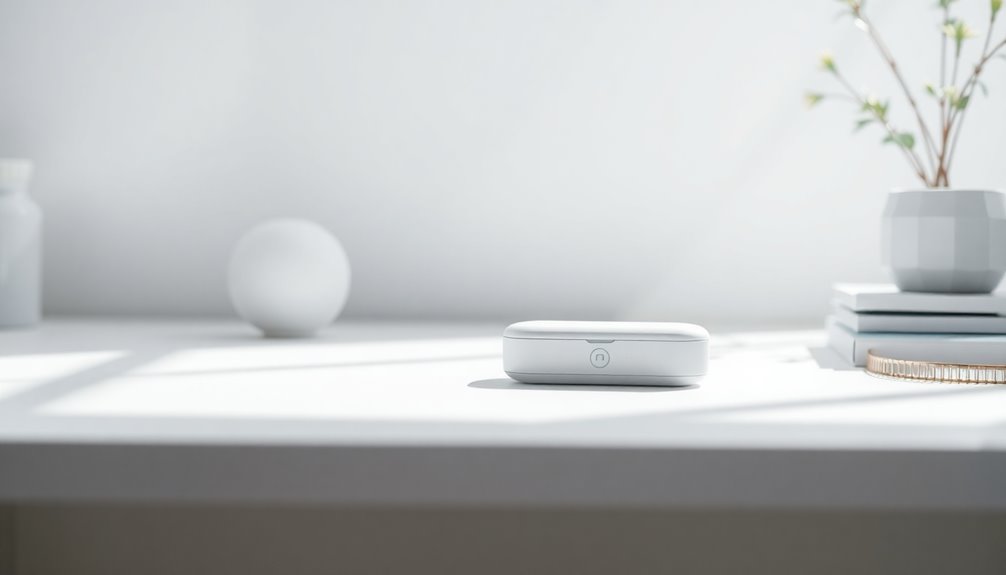
To create an effective e-commerce website, prioritizing minimalist design principles is essential for enhancing user experience. By adopting a minimalist approach, you can streamline your website design to focus on what truly matters.
Here are four key strategies to implement:
- Prioritize Whitespace: Use design elements that create breathing room around content, enhancing readability and engagement.
- Streamline Navigation: Limit menu items to essential categories, simplifying user journeys and reducing bounce rates.
- High-Quality Product Displays: Feature prominent images and concise descriptions to aid quicker decision-making without overwhelming users.
- Clear Call-to-Actions: Place obvious prompts throughout your site to guide users toward desired actions, boosting conversion rates.
Additionally, vetted content is crucial for ensuring that users find reliable information, which can further enhance their shopping experience. Implementing these principles will foster a more engaging and effective e-commerce experience.
Enhancing User Experience Through Minimalism
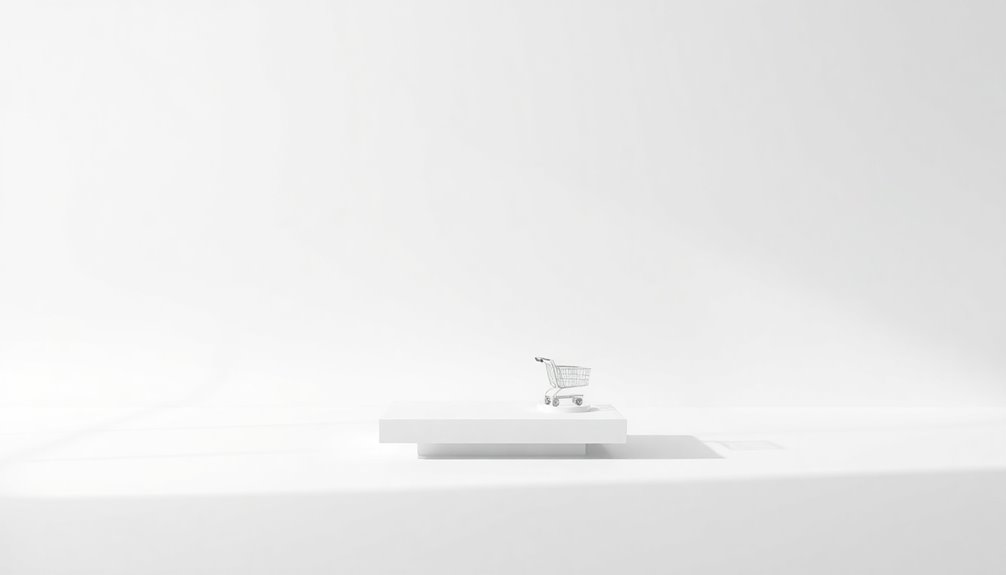
When you embrace minimalism in e-commerce design, you create a more intuitive and enjoyable shopping experience for your customers.
By adopting a design philosophy that prioritizes whitespace and streamlined navigation, you enhance user experience markedly. A decluttered interface allows users to focus on products without distractions, reducing decision fatigue and preventing analysis paralysis that often leads to abandoned carts.
With a clear visual hierarchy, essential elements like product images and calls to action grab user attention, streamlining the purchasing process.
Plus, minimalist design improves mobile responsiveness, ensuring a consistent experience across devices.
Ultimately, a well-executed minimalist approach not only boosts your online presence but also encourages higher conversion rates, making shopping more efficient and satisfying for users. Additionally, employing a budget plan can help you manage operational costs effectively while enhancing the shopping experience.
The Impact of Minimalism on Loading Times
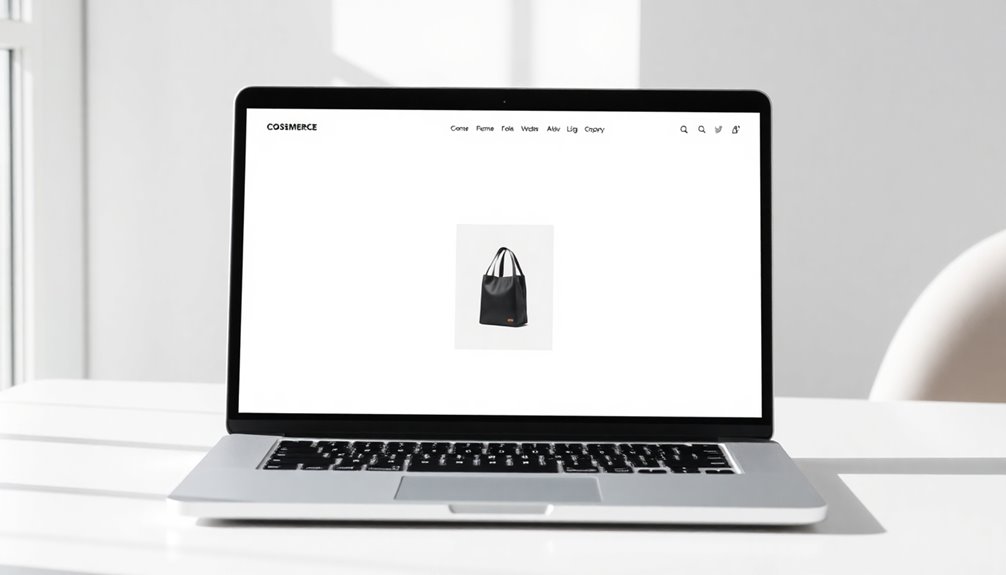
- Faster Loading Times: Minimalist designs often achieve loading times of under three seconds, which is essential for retaining users.
- Improved Site Speed: Streamlined content and optimized images lead to quicker responses and better browsing experiences.
- Higher Search Engine Rankings: Site speed is a critical factor in SEO algorithms, so faster sites rank better.
- Reduced Bounce Rates: With enhanced loading times, users are less likely to abandon your site, increasing conversion rates.
Additionally, adopting a minimalist approach can also help in achieving higher search engine rankings as site speed is a critical factor in SEO algorithms.
Embracing minimalism can considerably impact your e-commerce success.
Ensuring Mobile Responsiveness With Minimalist Designs
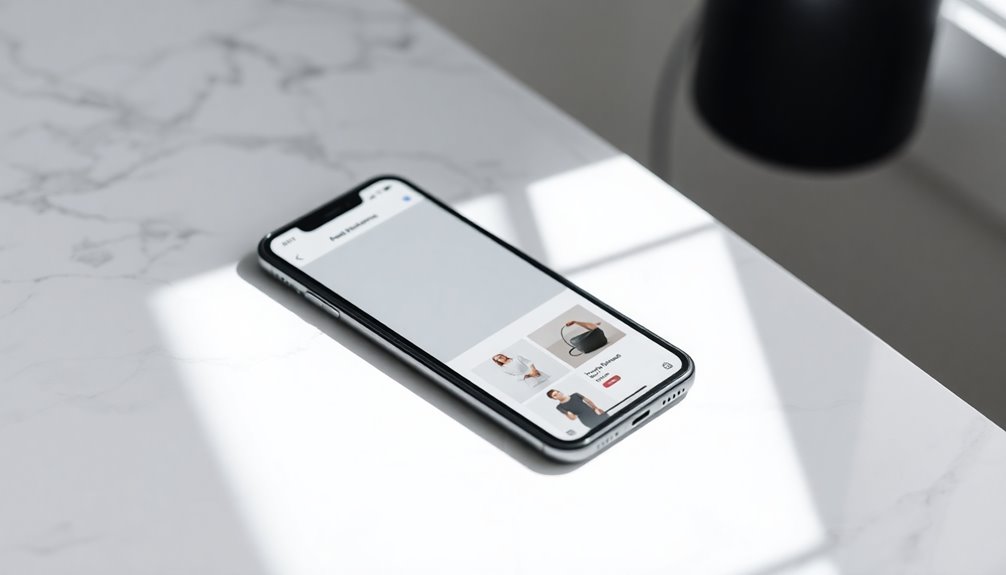
How can minimalist designs enhance mobile responsiveness in e-commerce? By simplifying layouts, minimalist design allows your website to adapt seamlessly to various screen sizes, which is crucial as over 50% of global e-commerce sales now happen on mobile devices.
This approach reduces clutter, improving loading speeds and user experience—53% of mobile visitors abandon pages that take longer than three seconds to load.
Focusing on essential elements directs user attention to critical actions, like product selection and checkout, boosting conversion rates.
Plus, mobile-responsive minimalist designs maintain consistent branding across devices, enhancing customer satisfaction and loyalty by 22%.
Ultimately, these designs help prevent decision fatigue, greatly reducing cart abandonment rates by addressing distractions and unnecessary information.
The Role of Design Teams in Minimalist E-Commerce Strategies

While minimalist design strategies can greatly enhance e-commerce platforms, it's the design teams that bring these visions to life. They guarantee that every element on a website serves a clear purpose, improving user navigation and minimizing clutter.
Here's how design teams contribute to minimalist e-commerce strategies:
- Visual Clarity: They prioritize high-quality visuals and ample whitespace, creating an inviting shopping environment.
- Collaborative Approach: Designers work closely with content writers to deliver concise messaging that aligns with minimalist principles.
- Data-Driven Decisions: Utilizing analytics, they assess the effectiveness of designs to boost conversion rates.
- Streamlined Layouts: By crafting clear calls-to-action, design teams guide users toward key actions, making purchases quicker and easier.
Frequently Asked Questions
How Does Minimalism Influence Brand Identity in E-Commerce?
Minimalism influences brand identity in e-commerce by stripping away excess and focusing on core values.
When you embrace a minimalist approach, your brand communicates clarity and intention. It makes your products stand out, allowing customers to connect emotionally.
Simple designs foster trust and enhance user experience, making it easier for visitors to navigate your site.
Can Minimalism Work for All Types of Online Businesses?
Imagine your online store as a tranquil oasis in a chaotic desert. Minimalism can indeed work for various online businesses, but it's not a one-size-fits-all solution.
You'll need to evaluate your brand's personality and target audience. For some, a clutter-free aesthetic enhances clarity and focus, while others might thrive on vibrant details.
Ultimately, you've got to strike a balance that keeps your brand's unique essence alive while embracing simplicity.
What Are Common Misconceptions About Minimalist Design?
You might think minimalist design means boring or empty spaces, but that's a common misconception.
It's not just about reducing elements; it's about enhancing functionality and focus.
Some believe it lacks personality, but effective minimalism can showcase a brand's unique identity.
Others worry it's too restrictive, yet it actually encourages creativity within a streamlined framework.
Embracing minimalism can lead to more engaging and intuitive experiences, not just a plain look.
How Do Customers Respond to Minimalist Versus Cluttered Designs?
Picture browsing a serene landscape versus a chaotic marketplace. When you encounter minimalist designs, your eyes glide effortlessly, drawing you into a calm experience. You feel focused and less overwhelmed.
In contrast, cluttered designs bombard you with distractions, making it hard to find what you want. Generally, you prefer the simplicity of minimalism, as it creates a sense of clarity and ease, enhancing your shopping experience while reducing decision fatigue.
What Tools Can Help Implement Minimalist Design Effectively?
To implement minimalist design effectively, you can use several tools.
Start with design software like Adobe XD or Figma for clean layouts. Utilize color palettes and typography tools such as Coolors and Google Fonts to maintain simplicity.
For web design, platforms like Squarespace or Shopify offer minimalist templates.
Finally, leverage user testing tools like Hotjar to gather feedback, ensuring your design resonates with your audience while staying uncluttered and functional.
Conclusion
In the fast-paced world of e-commerce, embracing minimalism is like clearing the clutter from a busy desk—it allows you to focus on what truly matters. By simplifying your design, you'll not only enhance user experience but also streamline processes, making your site more inviting and efficient. As you implement these principles, remember that less really can be more, creating a seamless journey for your customers that keeps them coming back for more.
